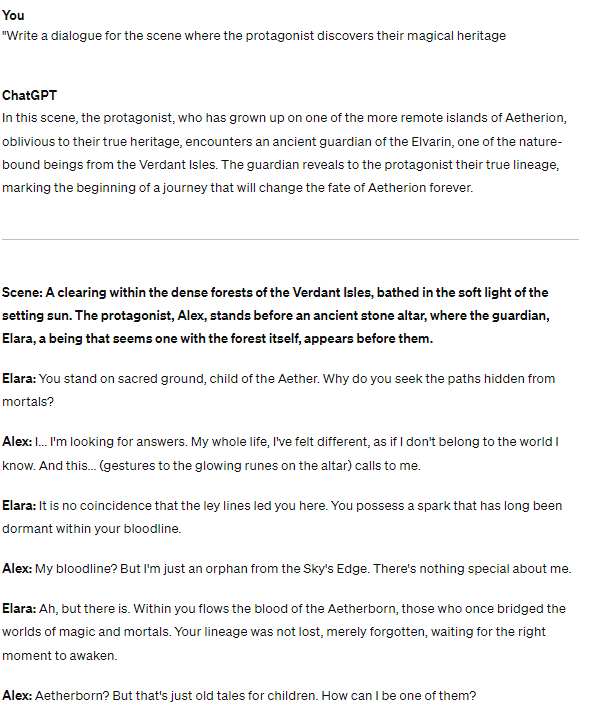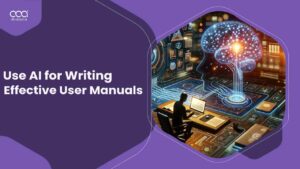The advent of the AI writing tools has revolutionized how narratives are crafted within the gaming industry. By merging creativity with efficiency, these tools have opened up new possibilities for developers to create engaging and complex stories.
They offer a dynamic approach to storytelling, leveraging the best AI writing tools in Brazil to automate mundane tasks while fostering a space for creative thought and innovation. Despite the transformative potential of these tools, understanding their practical applications and limitations remains crucial.
In this article, we will discuss “How to Write Video Game Narratives Using AI Writing Tools in Brazil” along with its importance in the writing world. What are you waiting for? Jump on the bandwagon to learn more about it in detail.
How to Write Video Game Narratives Using AI Writing Tools in Brazil – Step-By-Step Guide
Creating compelling game narratives is a complex process that requires creativity, storytelling skills, and a deep understanding of game mechanics. AI writing tools, like ChatGPT, can assist in streamlining this process and injecting innovative ideas into your storylines.
Here’s a step-by-step guide on How to Write Video Game Narratives Using AI Writing Tools in Brazil, accompanied by a continuous practical example focusing on developing a narrative for a fantasy adventure game.
Step 1: Conceptualize Your Game’s World
Objective: Begin by defining the universe where your game is set. This includes the era, the physical environment, cultural backdrops, and the laws that govern your world.
Practical Example:
I asked ChatGPT, “Help me create a detailed description of a fantasy world for a game, including its era, environment, and governing laws.” ChatGPT generated a rich backdrop of a mystical land suspended in eternal twilight, governed by ancient magic and divided among competing factions, setting the stage for intricate narratives.

Step 2: Define the Main Characters and Roles
Objective: Identify your protagonist, antagonist, and supporting characters. Define their roles, motivations, strengths, and weaknesses to ensure they are well-rounded and contribute meaningfully to the narrative.
Practical Example:
Continuing with our game world, I instructed, “Who are the main characters in this narrative, and what are their motivations?” ChatGPT suggested a protagonist who is the last scion of a magical lineage, an antagonist seeking to harness the realm’s magic for control, and allies to assist the protagonist.

Step 3: Outline the Main Plot and Subplots
Objective: Sketch out the central storyline and any secondary narratives that will unfold. This helps in creating a cohesive and engaging story that players can follow.
Practical Example:
I requested ChatGPT, “Outline a main quest and two subquests within this narrative.” The AI outlined a quest to restore balance to the realm’s magic, a subplot involving a search for ancient artifacts, and another subplot about uniting the realm’s factions against a common enemy.

Step 4: Script Key Scenes and Dialogues
Objective: With the plot in place, start scripting pivotal scenes and dialogues. This includes major encounters, discoveries, and turning points that drive the narrative forward.
Practical Example:
I asked ChatGPT, “Write a dialogue for the scene where the protagonist discovers their magical heritage.” ChatGPT crafted a dialogue revealing the protagonist’s legacy through an encounter with an ancient spirit, injecting emotion and depth into the narrative.

Step 5: Create a Detailed Draft of the Game Narrative
This step is about compiling all the elements you’ve developed—world-building, character arcs, main plot and subplots, dialogues, and lore—into a comprehensive draft. This draft should read as a cohesive narrative that can easily be translated into game design documents and scripts for development.
Practical Example:
After outlining the quests and subplots, I approached ChatGPT with a new request: “Combine all the elements we’ve discussed into a detailed draft of the game narrative.” ChatGPT synthesized the world description, character bios, main plot, side quests, and lore into a narrative draft.

Step 6: Integrate Narrative with Gameplay Mechanics
Objective: Ensure that the story elements seamlessly integrate with gameplay. This means aligning narrative developments with game levels, challenges, and player progression.
Practical Example:
I asked ChatGPT, “How can I align the quest to restore balance with game levels?” ChatGPT suggested structuring game levels as trials that test different aspects of the protagonist’s magic, each revealing part of the realm’s history and culminating in the restoration of balance.

Step 7: Iterate Based on Feedback
Use player feedback to refine the narrative and gameplay integration. This might involve adjusting the storyline, dialogues, or how the narrative unfolds through gameplay.
Practical Example:
After some playtesting feedback indicated that the story felt disconnected from gameplay, I asked ChatGPT, “How can I better integrate the story with game mechanics?” Based on ChatGPT’s suggestions, I revised levels to include more narrative-driven objectives and puzzles that reveal the backstory.

Step 8: Polish and Finalize the Narrative
Objective: Finalize your game’s narrative, ensuring that all elements are polished, cohesive, and ready for implementation into the game.
Practical Example:
To ensure the narrative was fully integrated and polished, I asked ChatGPT, “Review and suggest improvements for the final draft of the game narrative.” ChatGPT helped refine the language, ensure consistency in character voices, and verify that the narrative and subplots seamlessly intertwined with the gameplay mechanics.

The Transformative Power of AI Writing Tools
Now that you know “How to Write Video Game Narratives Using AI Writing Tools in Brazil” let’s move forward by exploring how AI writing tools are revolutionizing the creation of game narratives, making stories more engaging and interactive for a compelling gaming experience.
Generating Diverse Narrative Elements
AI writing tools that have the extraordinary ability to produce a wide array of narrative elements, from intricate character dialogues to richly detailed settings. This capability allows for the creation of varied and vibrant game worlds that can captivate players and keep them engaged.
Enhancing Story Complexity and Depth
By leveraging AI, developers can introduce greater complexity and depth into their stories without overwhelming the narrative structure. AI can suggest nuanced subplots and intricate character relationships, enriching the overall storytelling experience.
Streamlining the Development Process
The automation of certain narrative development tasks frees up creative resources, allowing teams to focus on the broader aspects of game design and storytelling. This efficiency not only accelerates the development process but also ensures that narrative quality is maintained throughout.
Necessity for Human Oversight
Despite the advancements in AI, human oversight remains crucial. Writers and developers play a key role in refining AI-generated content, ensuring that it aligns with the game’s vision and narrative goals. This collaborative approach between human creativity and AI capabilities ensures that the final narrative resonates with players.
Balancing AI Assistance and Creative Control
Finding the right balance between leveraging AI tools and maintaining creative control is essential. While AI can offer innovative ideas and solutions, the ultimate creative decisions should rest with the human developers to ensure that the game’s narrative remains authentic and engaging.
How Can Developers Effectively Use AI for Writing Game Narratives?
Integrating AI into the narrative creation process can significantly elevate the storytelling aspect of game development. Here’s how developers can effectively leverage AI writing tools:
Initiate with a clear framework:
Establish the main plot points and character arcs early on. This gives AI a solid foundation to generate detailed narratives that align with the initial vision, ensuring that the core storyline remains intact and coherent.
Iterate and refine:
View AI-generated content as a starting point. Developers should refine this content, enhancing it with human creativity to add depth, emotion, and subtlety that AI may not capture on its own.
Embrace experimentation:
AI’s capacity to generate unexpected narrative elements can be a powerful tool for creativity. Allowing AI to introduce novel plot twists or character developments can lead to unique and engaging storylines.
Incorporate player feedback:
AI tools can adapt narratives in real-time based on player interactions and choices, creating a dynamic storytelling environment that responds to player input and enhances engagement.
Ensure consistency:
Regular reviews of AI-generated content are essential to maintain the game’s tone, style, and narrative coherence. This ensures that all elements of the story align with the overarching vision and deliver a cohesive gaming experience.
By harnessing the capabilities of the best AI writing tools, developers can push the boundaries of game narrative development, creating stories that are not only complex and engaging but also deeply resonant with players.
What Role Do AI Tools Play in Game Narrative Design?
AI tools are becoming indispensable in the realm of game design, particularly in crafting compelling narratives. How to write video game narratives using AI writing tools in Brazil is becoming a key question for developers. By automating certain aspects of storytelling, these tools allow developers to focus on the broader narrative arc, ensuring a cohesive and engaging experience. The role of AI in game narrative design includes:
Generating Dialogue and Descriptions:
AI tools are transforming game narratives by crafting varied and dynamic dialogues. This innovation breathes life into character interactions, making them more engaging and believable, and significantly enhancing the player’s experience.

Building Branching Narratives:
By enabling the creation of complex storylines with multiple outcomes, AI tools offer players greater agency and replayability. These technologies facilitate the development of narratives that respond to player choices, making each gaming experience unique.
Enhancing Character Development:
AI significantly enriches character backstories and personalities, providing deeper narrative depth. This leads to more immersive gaming experiences as players feel more connected to well-developed characters.
Streamlining Content Creation:
AI tools streamline the narrative development process by quickly generating content for various scenarios. This ensures a consistent storytelling flow, reducing the workload on narrative developers.
Improving Narrative Pacing:
Leveraging AI’s analytical capabilities allows for the adjustment of story pacing to match player progression. This ensures that the narrative tempo contributes to an optimal gaming experience.
How AI Tools Enhance Art and Design in Games?
Beyond narratives, AI tools significantly contribute to the art and design aspects of game development. They assist in creating both 2D and 3D assets, enabling designers to bring their visions to life with greater efficiency and detail. The impact of AI on art and design includes:
Automated Asset Creation:
AI accelerates the generation of complex textures and models, enhancing visual details and reducing development time. This allows for quicker iterations and richer game environments.
Style Adaptation:
By replicating specific art styles across assets, AI ensures a cohesive visual identity throughout a game. This reduces manual effort and maintains consistency in design.
Efficiency in Animation:
AI tools automate animations, ensuring smooth and realistic movements that enhance the game’s visual storytelling. This adds to the immersive experience of the game.
Enhanced Creativity:
AI algorithms suggest innovative design elements that align with the game’s theme, pushing creative boundaries and introducing originality into game design.
Scalability:
AI facilitates easy modification and scaling of assets, supporting the creation of diverse and expansive game worlds. This adaptability enhances the game’s visual appeal and variety.
What Are the Limitations of AI Writing Tools in Game Storytelling?
While AI writing tools offer numerous advantages, they are not without their challenges. Developers must navigate these limitations to fully harness the potential of AI in storytelling. Key concerns include:
Repetition and Predictability:
AI’s tendency to generate repetitive and predictable content can diminish the freshness and appeal of game narratives. Players might find the storytelling formulaic, reducing the game’s overall allure and engagement.

Understanding Nuance:
AI often lacks the capability to fully grasp and convey the complexities of human emotions, leading to character interactions that may seem shallow or unconvincing. This limitation can undermine the emotional depth and relatability of the game’s narrative.
Ethical Considerations:
The use of AI in narrative creation poses ethical challenges, particularly in handling sensitive topics or cultural nuances. Without proper oversight, AI-generated content could inadvertently perpetuate stereotypes or offend players, necessitating vigilant monitoring.
Dependency:
Relying too heavily on AI for narrative creation can curb the creative input of human writers, who bring invaluable originality and innovation to storytelling. This overdependence risks undervaluing the human touch that is critical in crafting compelling and imaginative narratives.
Integration Complexities:
The challenge of integrating AI-generated content with manually written narratives can lead to inconsistencies and disrupt the story’s flow. Achieving a seamless narrative experience requires extensive editing and fine-tuning, which can be both time-consuming and resource-intensive.
What Future Developments Can We Expect in AI-Driven Game Narrative Design?
The future of AI in game narrative design is bright, with ongoing advancements poised to further transform the landscape. Emerging technologies and tools promise to overcome current limitations and open up new possibilities for storytelling. Anticipated developments include:
Advanced Context Understanding:
Future AI tools are expected to have an enhanced ability to grasp complex narrative contexts, leading to storytelling that is more sophisticated and relevant to the game’s world. This will provide players with a more nuanced and engaging gaming experience, where the narrative feels deeply interconnected with the game’s mechanics and player decisions.
Interactive Storytelling:
With advancements in AI, games will be able to adapt narratives in real-time based on player choices and actions, offering a highly personalized gaming experience. This means that the story can evolve in unique directions for each player, making the game more immersive and emotionally engaging.
Cross-medium Integration:
The next generation of AI tools will facilitate the creation of game narratives that span across various platforms, including social media, mobile apps, and more. This approach will expand the narrative experience, allowing players to engage with the game’s story in innovative ways outside of the traditional gaming environment.

Ethical AI Development:
There will be an increased emphasis on creating AI tools that are mindful of ethical considerations, ensuring that narratives are sensitive to cultural and social norms. This focus aims to prevent the generation of content that could be harmful or offensive, promoting a more inclusive and respectful gaming environment.
Collaborative AI-human Interfaces:
Future developments are set to improve the interfaces through which game developers and AI tools interact, making the process of narrative design more collaborative. This will allow for a seamless blend of AI-generated content and human creativity, leading to richer and more innovative game stories that push the limits of current storytelling practices.
FAQs
Here are some of the most commonly asked questions about “How to Write Video Game Narratives Using AI Writing Tools in Brazil”
Can AI Write a Game?
How AI is Used in Games?
Is AI Good for Video Games?
What is the Future of AI in Games in Brazil?
Conclusion
AI’s integration into game development represents a transformative shift, offering unparalleled opportunities for creativity and innovation. As AI technologies evolve, the synergy between AI-driven tools and human creativity will continue to redefine the boundaries of game design, narrative complexity, and player engagement.
In this article, we have comprehensively discussed “How to Write Video Game Narratives Using AI Writing Tools in Brazil” and everything related to it. To learn more about how to use AI in different fields, domains, and personas check out articles in our “How-To Guides“. Moreover, you can learn about different AI terms and concepts in our AI Lexicon.





